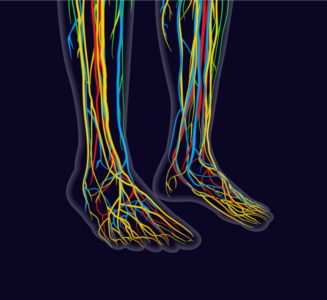 Your sural nerve is a sensory nerve in the calf region that runs down your leg and through the lateral side of your foot and toe. It has a few different branches, and if any of these areas become compressed or irritated, pain and discomfort can develop. In today’s blog, we take a closer look at when irritation of the nerve causes a condition known as sural neuritis.
Your sural nerve is a sensory nerve in the calf region that runs down your leg and through the lateral side of your foot and toe. It has a few different branches, and if any of these areas become compressed or irritated, pain and discomfort can develop. In today’s blog, we take a closer look at when irritation of the nerve causes a condition known as sural neuritis.
Causes And Symptoms Of Sural Neuritis
Sural neuritis, also referred to as sural neuralgia, develops when an area of the sural nerve becomes entrapped, irritated or damaged. The most common cause of sural nerve damage is as a result of trauma to the leg, but it can also develop after a surgery if scar tissue ends up enveloping part of the nerve. A severe ankle sprain, a hard fall, or a collision during athletics or a can accident are the most common mechanisms of nerve damage.
Symptoms of sural nerve damage include:
- Pain on the outside of the foot or ankle
- Discomfort that is described as a burning sensation
- Localized hypersensitivity
- Numbness
- Swelling
Symptoms also tend to get worse when there is pressure on the area, which is why certain footwear can exacerbate discomfort.
Treating Sural Neuritis
Treating sural neuritis depends on the root cause of its development. For example, the most common cause of sural neuritis is from a moderate to severe ankle sprain that results in the stretching of the nerve. In these instances where the nerve has been stressed, sometimes symptoms resolve on their own with time and nonoperative techniques. Some common non-operative techniques include rest, desensitization massage, medications, changing footwear, corticosteroid injections and physical therapy or range of motion exercises. The sural nerve symptoms tend to resolve as the underlying ankle injury heals.
If non-operative techniques fail to provide relief, surgery may be necessary. This is generally accomplished in one of two ways:
Nerve Decompression – Surgery works to release the nerve from surrounding scar tissue or nearby irritating structures. Rehabilitation measures may be focused on breaking up scar tissue as it forms to prevent a recurrence.
Nerve Resection – If the nerve is severely damaged or scarred, part of the nerve may be removed with a resection procedure. Doing so may result in the loss of sensation in the outside of the foot, but this is often preferred to constant pain or discomfort.